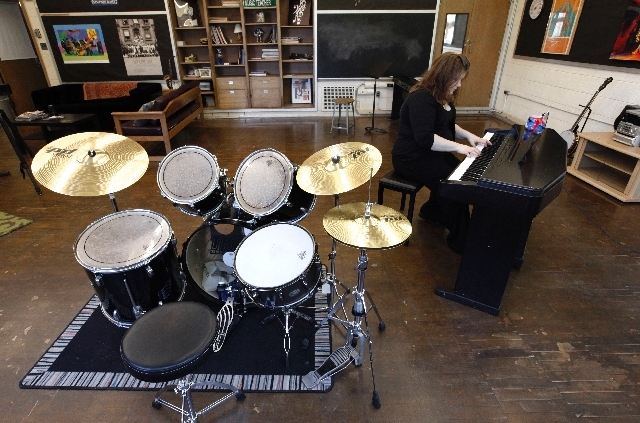Detroit finds new uses for old school buildings

DETROIT — When it was a high school, the auditorium and gymnasium at the Burton International School thrummed with the sounds of students gathering for assemblies or bouncing balls. These days, film dialogue and soundtracks fill the nearly 100-year-old building, which has found new life as a movie theater.
Developer Joel Landy remade the school into the Cass City Cinema at the Burton Theater.
“It had all the seats and a projection booth built in 1924,” Landy said. “That kind of clinched it.”
Burton was among dozens of Detroit public schools forced to close in recent years as the district sank into debt and parents sought better education options. Now the city is getting high marks for its efforts to reuse those buildings – as churches, substances-abuse centers, housing and more.
The practice also offers lessons to other districts confronting the same challenges.
“Detroit has more experience with finding new uses because it has had more empty buildings on its hands,” said Emily Dowdall, a senior associate with the Philadelphia-based Pew Charitable Trusts, a public policy organization that released a report earlier this year on the growing number of vacant schools in a dozen U.S. cities.
Some of the nation’s largest school districts have seen their enrollment plummet and budget deficits rise, forcing them to close half-empty buildings and those that are too costly to maintain. Chicago expects to shutter 50 schools and programs before fall classes begin. A reform board in Philadelphia has voted to close 23 schools.
“Many districts are now on their second and third round of closings” and are increasingly looking at the practices of other cities, including Detroit, Dowdall said.
The Detroit district has made more than $16 million by selling or leasing closed schools and vacant land. Forty schools have been sold. Another 45 are leased, according to the district. More than 80 schools are listed as available.
Between 2000 and 2010, Detroit’s population dropped by more than a quarter of a million, to just over 700,000 people. By 2008, public school enrollment had slipped below 100,000 students. It’s projected to fall to 40,000 by 2016.
About seven years ago, officials padlocked 35 schools, followed by 29 more in 2009. Of 172 schools that were open in 2010, 100 remain open.
Landy bought four old school buildings in Detroit. One is now a charter academy. Another was turned into lofts. A third houses a music school and recording studio.
He bought the old Burton International School building four years ago for about $400,000. Movies are shown on weekends. It also has a Montessori school.
At least one shuttered Detroit school is now used as a church. The former West Side Academy houses substances-abuse programs.
Carole Hoste teaches music in one of Landy’s buildings.
It makes sense for the school district to sell the buildings “if they can get a quick chunk of money,” she said. “I don’t know why they weren’t doing that a long time ago.”
Detroit no longer sells to charter schools, which compete for students and state funding. But the city is aggressive in its efforts to sell and lease buildings, said Tammy Deane, a former residential and commercial real estate broker who manages the district’s real estate office.
Buildings have sold for as little as $5 per square foot. Vacant land has fetched about $100,000 an acre.
“We work with anyone and everyone, and try to be very creative to move properties and help visionary buyers realize their dreams,” Deane said. “We want the new owners to move in soon as we move out.”
That’s to deter thieves who target vacant buildings to strip out their electrical wiring and pipes for sale as scrap metal.
Other districts have also had success with school recycling.
The Kennedy School in Portland, Ore., was boarded up for years. The lawn wasn’t being cut, and the property “just didn’t look good,” said Thelma Diggs, who was part of a committee that reviewed options for the site’s future.
“I wasn’t even considering tearing it down,” Diggs said. “If you can use all that money to tear it down, why not keep it?”
McMenamins, developer of pubs and historic hotels in Oregon and Washington state, got the building from the city at no cost in 1996 and turned it into a 57-room hotel. The company is required to provide 15 years of free meeting room space to a neighborhood association. It also allows neighbors to use the hotel’s soaking pool.
“A hotel project is super cool,” but it may not fit plans for many school districts or neighborhoods, said Shannon Jaax, director of the Kansas City Public Schools’ “repurposing initiative.”
When that program kicked off in January 2011, the district had 30 empty schools. Six have since been sold and another is under lease with an option to buy.
A recent sale, Seven Oaks School, had been closed since 1997 and will be repurposed as affordable senior housing.
“Some school districts have been trying to maximize price,” Jaax said. “What we are trying to do is balance the need to be financially responsible, (while) looking at what type of project will be the best fit in the community.”
Chicago schools are just beginning the process. The district plans to work with community leaders to determine the best use for closed buildings.
“If there is no strong use for the community or for a sister city agency,” the district “will explore selling each property to the highest bidder,” spokesman Dave Miranda said.
They could also use someone like Detroit’s Landy.
Not one to throw away anything with value, Landy moved a used pool table into a bathroom at the school-turned-movie house. It sits between urinals and stalls.
“Reuse,” he said “is the ultimate form of recycling.”